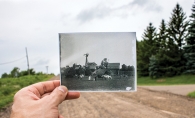Virginias everywhere know there is a Santa Claus, thanks to Virginia O’Hanlon’s famous letter to the New York Sun in 1897. Woodbury residents Arlan & Virginia Tietel have been celebrating the whimsical spirit of that letter through the United States Postal Service for at least 25 years. Every year the postage on their Christmas cards is cancelled in a city with a festive holiday name. Snowville, Utah; Angelica, New York; Garland, Texas and Christchurch, New Zealand are just a few of the far-flung post offices the Tietels have used to send their unique brand of Christmas cheer.
In the early days, they waited until every envelope was stuffed and sealed before choosing the city to forward their cards. But over the years, they’ve learned to plan ahead. “The decision for our 2013 card was made in February,” Arlan says. Virginia adds, “It’s best to start planning early.”
Year after year, as a nod to Arlan’s passion for model trains, their Christmas card features a locomotive somewhere in the design. They search high and low for cards all year long, and keep a 4–5 year stockpile at the ready. With a mailing list that includes 125 recipients, finding the right design in sufficient quantities can be a challenge. Over the years, the trains have become harder to spot. “It may not be obvious, kind of like ‘Where’s Waldo’,” Arlan says. The train might be a toy peaking out of the top of Santa’s bag of gifts, or behind the glass of an elaborate Christmas window display.
The challenge of finding the train pales in comparison with the task of writing, proofreading, signing, stuffing, stamping and labeling all those cards before Thanksgiving. “That always causes some household pressure and tension,” Arlan says with a smile. Next, all of the stamped cards are placed in a flat rate box, along with a letter and box of candy for the postmaster of the chosen city, whom they’ve usually contacted in advance via telephone. When the letters arrive at the chosen city, the letters are removed from the box, the postage is cancelled and the letters are mailed to their final destinations from there.
Friends love finding the Tietel’s annual letter in their mailboxes. The tradition conjurs the same excitement of a child rushing down the stairs on Christmas morning. Barbara Gorka wasn’t sure how they managed to get those unique post marks every year. “I just thought they were well traveled,” she laughs. Mary Jane Rohde, who with husband Paul, is another longtime member of the Tietel’s mailing list, says “I’m always looking forward to see where it’ll be from. I keep thinking they’re going to run out of places, but they never seem to.”
The Tietels have learned a great deal in their postmark research, from city history to colorful postmasters in rural towns. In Mistletoe, Kentucky, they discovered that the post office is run out of a family home. When Arlan asked how many people lived in Mistletoe, the post-master said “We have 14 souls living in the holler.” Presumably all 14 of those souls come to his home to help him cancel around 15,000 pieces of mail at Christmas time. “Some places don’t have paid staff to do this and rely on volunteers,” Arlan says. It can range from 5,000 to 15,000 pieces of mail, depending on the city. The year the Tietels had their cards cancelled in Mistletoe, the imprint design featured a couple kissing under a bunch of mistletoe.
The Tietels have advice for others considering a similar project. It sounds silly, but be sure to send a card to yourself. They didn’t do that in the first few years of their project, and now wish they had those first two cards to round out their collection. Is it too much work? No way, Arlan says. “It’s not work at all; it’s just fun. For us, Christmas is a year-round celebration about giving and receiving. We believe every day is Christmas.”









